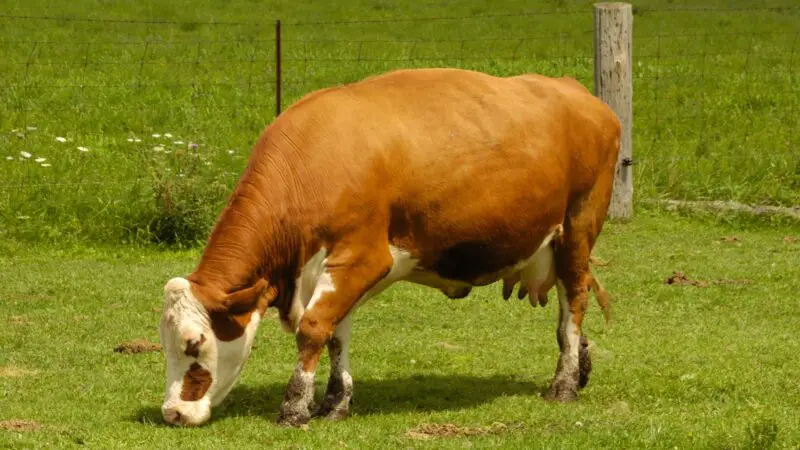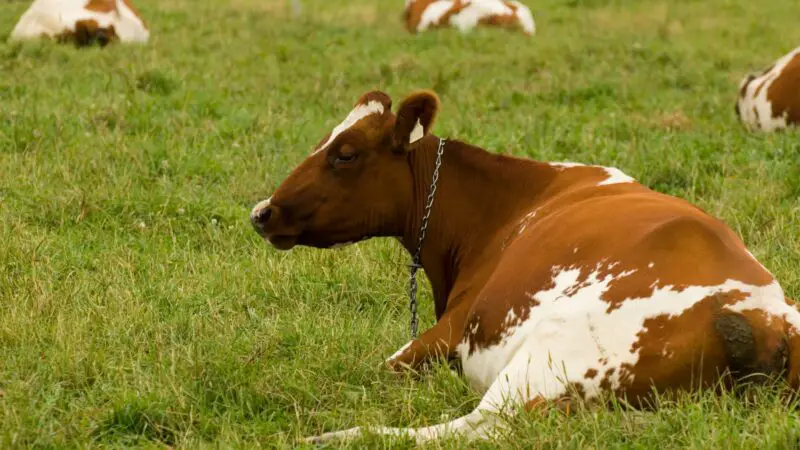Guernsey cows are fawn or wheat-colored, medium-sized cows from the Isle of Guernsey, hence their name. They were brought to America in the 19th century and have since been a significant breed in the American dairy industry.
Guernsey cow is known for producing protein- and butterfat-rich, golden-colored milk, which also contains high amounts of carotene. Although it is primarily raised for milk, it can also produce quality beef.
This article discusses everything you need to know about the Guernsey cow, including its history, appearance, milk-producing abilities, temperament, and other interesting information. Read further for more!
What Do Guernsey Cows Look Like?

Guernsey cows are a medium-bodied breed known for their delicate looks. They have a light reddish-brown or fawn and white coat with clearly defined hide markings.
They are characterized by a graceful gait, wide rump, sturdy back, and steady hindquarters. These cows are usually horned, but there are also polled animals.
How Long Does a Guernsey Cow Live?
Their average life expectancy is 10 to 12 years, but they can live as long as 20.
What Do Guernsey Cows Eat?
Guernsey cows are herbivores that forage for grass, shrubs, and legumes. Owners will also supplement them with silages such as alfalfa, ryegrass, corn silages, and hays such as Timothy. They can also be fed with byproducts from human food, such as cottonseeds, almond hulls, and soybean meals.
They are usually fed a dietary premix prescribed by a professional nutritionist for their mineral and vitamin requirements. This may include fruits and vegetables that begin to spoil, such as potatoes, sugar beets, pumpkins, oranges, and pinto beans.
How Big Do Guernsey Cow Grow?
Although they have no exact measurements, mature, medium-sized cows are about 160 to 180 centimeters tall at the shoulder.
Is Guernsey Cow a Heavy Breed?
Guernsey Cow is not a heavy breed; they are of intermediate weight. Cows weigh 1,400 pounds, while bulls weigh 2,000 pounds.
What Is Guernsey Cow Known For?
Guernsey cows are known and grown primarily for their golden-colored milk, which has exceptionally high amounts of carotene, butterfat, and protein. They produce milk by consuming 20% to 30% less feed per pound than other larger dairy breeds.
Distinct Characteristics
They are excellent grazers for pasture-based milk production, have great calving ease, and can mature and breed earlier. They also have a lower projected calving interval and can produce milk efficiently using less feed than other breeds. Lastly, they are the only known breed without documented undesirable genetic disorders.
Guernsey Cow Temperament
Guernsey cows are known for their quiet and extremely docile dispositions. They are kind and gentle, which makes them easy to work with.
Are They Good for Beef?

Guernsey cows are good for beef. Although Guernseys are raised primarily for dairy, they can also be raised for quality meat. Guernsey beef is deep and buttery in flavor and has a rich marbling. Like its milk, its beef is also high in beta-carotene.
How Much Does a Guernsey Cow Cost?
Guernseys range around $500 to $1,300 depending on their age, milk-producing capabilities, cost of raising them (whether they are hand-raised and bottle-fed), and pregnancy or lactation status. Mature cows can cost as much as $4,000 to $5,000.
Tips for Taking Care of Guernsey Cow

Spacing
- Fresh cows. They need extra room to be able to lunge forward and stand. The stall width should be 45 to 48 inches, while its length should be 8 to 8.5 feet. They should also have a minimum of 30 inches of bunk space.
- Lactating cows. It requires the same space as fresh cows, but bunk space can be around 24 to 30 inches.
- Dry cows. These cows require 50 to 100 square feet of space. If possible, they should have a separate area for calving which should be ten by 14 feet or 12 by 12 feet. The bunk space should be a minimum of 24 inches.
Housing
Facilities that protect from muddy conditions and heat stress are adequate for keeping the Guernsey cows. They can be semi-confined or confined units if they provide enough space for each cow. Young calves should be placed in calf hutches or enclosed barns, while older replacement heifers do not necessarily need housing.
If you don’t have any housing for your cow/s, make sure they have access to shade and cooling, especially during heat waves, droughts, and the winter season.
Milking Center
Over half the time an owner has will be spent in this facility. It should include a holding area, milking parlor, utility room, milk room, and treatment area.
Usually, herringbone and side-opening parlors are the main buildings used for milking centers, but you can also use carousels, walk-throughs, flat barns, and parallel parlors.
Feeding and Nutrition
A cow should be consuming at least 4% of its body weight. Cows should be provided with feed bunks that are regularly cleaned and maintained. These bunks should have soft, dry floors to avoid hoof injuries and be free of rough edges and surfaces.
Guernseys should be fed with a nutritionally-balanced, total mixed ration (TMR) containing forage items (usually corn silage, grass silage, and hay), concentrates (protein supplements and commercial grain mixes), human food byproducts (fruits and vegetables), and a dietary premix prepared by a nutritionist. Clean water should be available to the cows at all times.
Owners should have feed storage, observe the inventory of forage and feed delivery to all cows, and minimize wastage.
Grooming and Clipping
Guernseys can have their hair clipped using clipper blades. However, you need a local breeder, extension agent, or other trained professionals to assist you. Hoof trimming should also be done to reduce the risk of getting hurt by the animals accidentally kicking you.
Health Management
The cows should undergo deworming, vaccination programs, and other health procedures prescribed by a veterinarian to ensure that your cow and/or herd is healthy. Some common diseases that need professional treatment are foot rot, strongyle worms, scours, brucellosis, and mastitis.
Sanitation
Lastly, the cow’s facilities and housing should be regularly inspected and maintained. Moreover, cows themselves should be cleaned and sanitized. Their milk should be routinely checked for any bacteria so that it is safe for human consumption.
Is It Expensive to Raise Guernsey Cow?
It varies per owner. Feed costs are around $1,300, livestock costs (which includes dairy supplies, veterinary and medicine, marketing, electricity, etc.) are around a minimum of $300, and facilities and equipment costs are around $300 minimum, depending on if you already have them pre-constructed or otherwise.
How Much Space Does a Guernsey Cow Need?
Guernseys would need at least 35 square feet of space per head. Dry cows usually need about 50 to 100 square feet of space each.
Related Questions
What’s the Difference Between a Jersey Cow and a Guernsey Cow?
| Characteristics | Jersey Cow | Guernsey Cow |
| Appearance | Usually dark brown, slightly reddish, or mixed in color. | Light reddish-brown or fawn and white with hide markings or patterns |
| Size and weight | Small; 800 to 1,200 pounds | Medium; 1,400 to 2,000 pounds |
| Temperament | Skittish and are known to run and buck | Docile, kind, gentle, and quiet |
How Much Milk Can They Produce per Day?
Guernsey cows can produce 18 to 26 liters of milk, a moderate amount for dairy cows.
Why Is Guernsey Butter So Yellow?
Guernsey butter is so yellow because it contains high levels of carotene and butterfat, which are responsible for the yellowish color.
History & Origins

Guernsey cows come from the Isle of Guernsey, a small island found in the English Channel, just off the coast of France. They are descendants of a mix of the best Norman Brindles and Froment du Leon breeds, French cattle.
About 960 A.D., the Duke of Normandy sent a group of monks to the island of Guernsey to educate natives about cultivating the soil and defending the land. The monks brought the best French cattle—the Norman Brindles from Isigny and the Froment du Leon from Brittany, then developed the Guernsey cow.
Importation of French cattle to the island of Guernsey was lawfully forbidden in 1819, but British cattle imports persevered until 1977. Some cattle that survived the Second World War from Alderney also merged into the breed. Dutch cattle were also thought to have influenced the genetic lineage of Guernsey in the 18th century.
The Guernsey cows were introduced to America around September 1840 when 3 cows, 2 heifers, and 1 bull were brought to New York. These animals served as the original stock of most Guernseys, making up the national herd we know today. In 1877, the Guernsey Cattle Club was founded.
About 2,500 annual registrations for Guernsey cows and about 10,000 total Guernseys worldwide. The breed is significant in the American dairy industry and is used as a purebred.
Guernsey cows are known for their golden-colored milk, which contains high amounts of butterfat, protein, and carotene. They are also known for having a younger average age of first calf heifers than larger breeds.
List of Sources
Starting a Dairy Cow Operation
History of Dairy Cow Breeds: Guernsey
